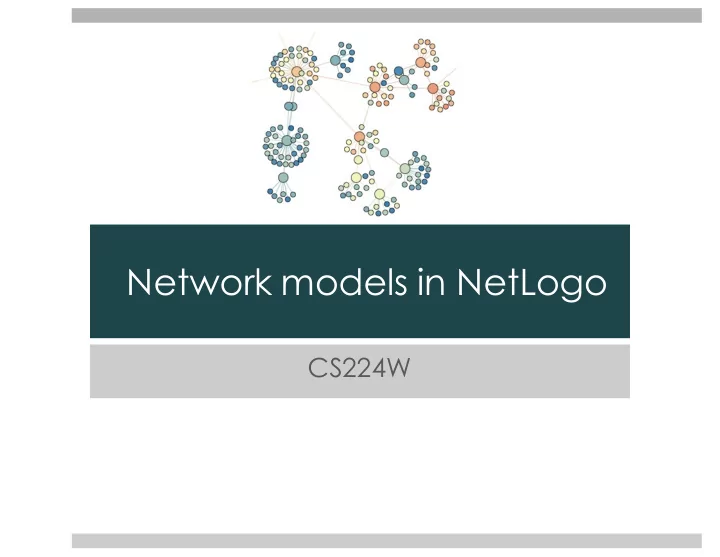

Network models in NetLogo CS224W
Outline ¤ Why model? Why with agents? ¤ NetLogo: the Agent Based Modeling (ABM) language we will be using ¤ Issues in ABMs: ¤ updating ¤ robustness/sensitivity ¤ reproducibility
Software: NetLogo ¤ a language built specifically for agent based modeling ¤ a modeling environment ¤ interactively adjust parameters ¤ feedback through plots & visualizations
What is a complex system? ¤ A large population of interacting agents ¤ No centralized control ¤ Emergent global dynamics (e.g. coordination) from distributed interactions
Why model? ¤ Gain understanding of system ¤ Make predictions about what system will do when parameters reach yet-unseen values ¤ Re-run the past
Why model with agents? ¤ Agents are more cooperative and less expensive than human subjects J ¤ Some systems cannot be solved analytically ¤ or the interesting part is the path dependence and not the average behavior ¤ Flexibility: ¤ different agent types, behaviors, constraints
Example: threads ¤ Colleague asks: why is the distribution of replies per thread so skewed? Are some better than others? Or could it be random? http://web.stanford.edu/class/cs224w/NetLogo/nonnetwork/threads.nlogo
Example: segregation In models library
Example: standing ovation http://web.stanford.edu/class/cs224w/NetLogo/nonnetwork/ StandingOvation2.nlogo
model types ¤ deterministic ¤ stochastic (contain randomness) ¤ evolving
Deterministic: flocking In model library
Stochastic: network growth http://web.stanford.edu/class/cs224w/NetLogo/RAndPrefAttachment.nlogo
Stochastic: termites In models library
stochastic: cow cooperation In models library
Evolving: genetic algorithms In models library: simple genetic algorithms
What is a model? ¤ A simplified mathematical representation of a system. ¤ Only include features essential to explaining phenomenon of interest
Modeling vs. simulation ¤ simulation: add detail to make the simulation as realistic as possible ¤ model: simplify as much as possible to glean essential behavior of system
example of simulation: Episims
Using Episims to model a smallpox outbreak in Portland, OR
What a model in NetLogo looks like
other example applications ¤ urban models ¤ opinion dynamics ¤ consumer behavior ¤ network effects and lock-in ¤ market for lemons ¤ networks of firms ¤ supply chain management ¤ electricity markets
wrap up ¤ complex networks are complex systems ¤ modeling lets you get to the heart of the matter (or the complex system) cheaply ¤ you specify simple micro rules and gain an understanding of the target macro behavior
Recommend
More recommend